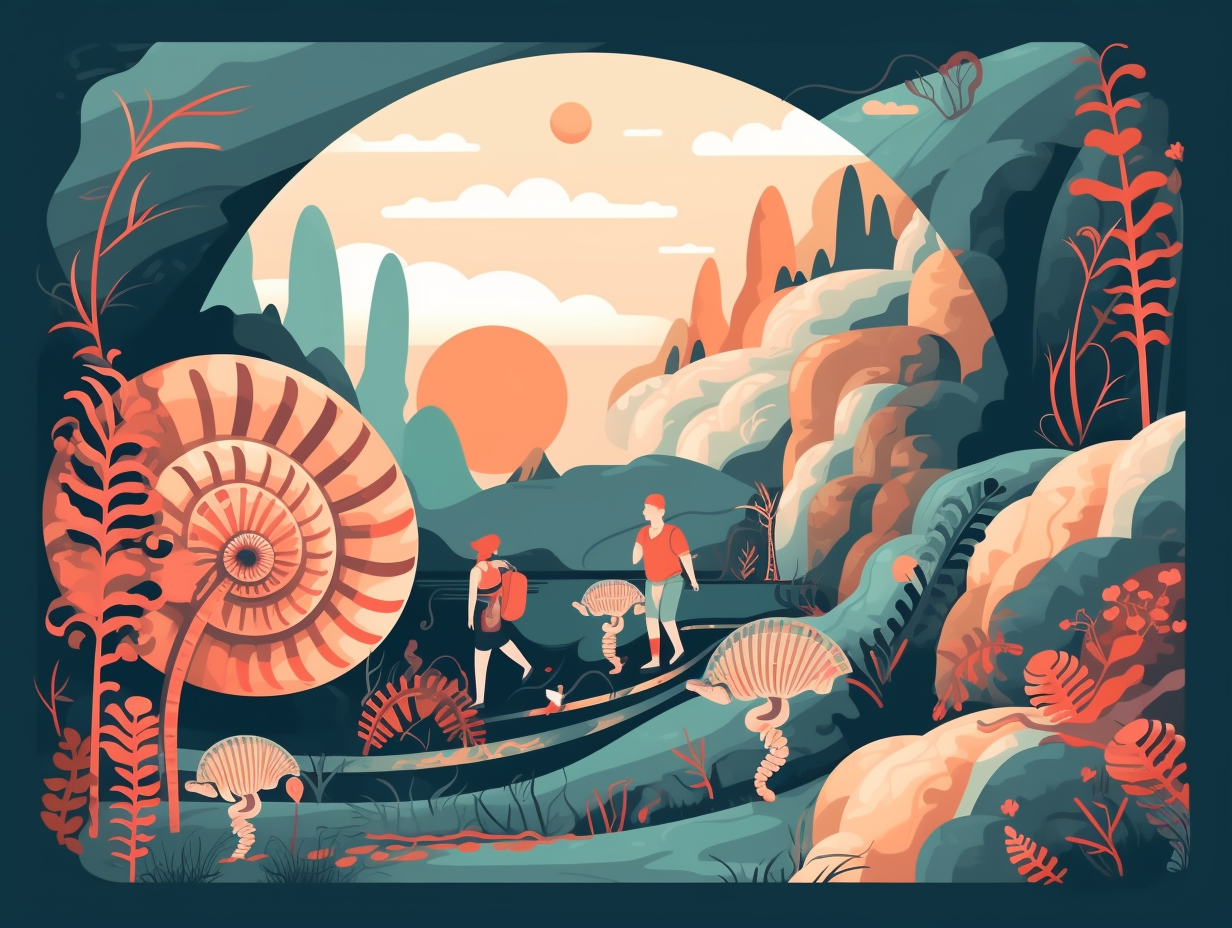Discover the Deep: Top 22 Fascinating and Fun Facts About the Ocean

1. Chiropractor from Hell
Imagine you're enjoying a deep-sea vacation, shrunk down to the size of a postage stamp, when suddenly you find yourself at the chiropractor from hell who decides to stack five jumbo jets on top of you: At the Mariana Trench's deepest point, the pressure equals about 8 tons per square inch, making this wild scenario feel all too real!
Source => pmel.noaa.gov
2. Natural Salt Bae
Who needs a salt bae when you've got Mother Nature? Rivers and streams are like Earth's natural salt shakers, gracefully seasoning the ocean's waters: An astonishing four billion tons of dissolved salts are carried to the ocean annually, but fear not – salt deposits on the ocean floor keep things in equilibrium, ensuring the water doesn't turn into a brine pool.
Source => oceanservice.noaa.gov

Did you know tornadoes have a signature dance move based on their location? Discover the spinning twist that sets northern and southern hemisphere tornadoes apart! 🌪️ 💃
=> Fun Facts about Tornadoes
3. Salty, Deep Surprises
You know what's salty, deep, and full of surprises? No, not your favorite bag of chips or that overrated crime documentary - it's the ocean, of course! Ready to dive into some knowledge?: Almost all of Earth's water (96.5 percent) is saline and found in the oceans, while only 2.5% is freshwater, essential for the survival of humans, plants, and animals. Of that tiny percentage, most is trapped in ice and ground, leaving just 1.2% for surface water use, and rivers holding a measly 0.49% of the freshwater pie.
Source => usgs.gov
4. Poseidon's Housewarming Party
If Poseidon ever threw a housewarming party, the guest list would be absolutely mind-blowing: The Great Barrier Reef is where Nemo, Jaws, Crush the turtle, and about 1,497 other species of fish share the ultimate undersea pad. Fancy an invite? Here's the deal: Stretching across 1,243 miles and covering an area of 135,136 square miles, the Great Barrier Reef is not only the world's largest living structure but also boasts a dazzling array of marine life, an exclusive World Heritage title, and the bragging rights of being the world's most protected marine area.
Source => livescience.com

5. The Real Upside Down
Forget the Upside Down from Stranger Things - the real-life ocean version is gigantic, unexpectedly bustling, and way cooler: Covering 95% of the seafloor, the deep sea is home to a myriad of oddball creatures that thrive in harsh conditions like crushing pressure, near-freezing temperatures, and utter darkness, somehow making a living in a world more mysterious than any Netflix series!
Source => letstalkscience.ca
6. Ocean's Unexplored Areas
You might say our knowledge of the ocean is just the tip of some wet, salty, Neptune-sized iceberg: only about 7% of the world's oceans are designated as marine protected areas (MPAs), leaving the majority vulnerable to environmental threats and desperate for a little exploration and preservation love.
Source => oceana.org
7. Underwater Lakes & Rivers
Water you waiting for, folks? Even Poseidon himself would double-take at this sea-dweller's real estate secret: In the Gulf of Mexico, there are underwater lakes and rivers, complete with shorelines and waves, providing a cozy home to specially-adapted mussels that savor the taste of methane-munching bacteria.
Source => oceantoday.noaa.gov
8. Twilight Zone VIP Lounge
If there were an underwater nightclub, the Twilight Zone would be the mysterious VIP lounge hidden away from prying eyes: This elusive ocean realm, extending from about 600 feet deep down to 3000 feet, houses eerie creatures like lantern fish, viperfish, and bioluminescent beings, all thriving in a dimly lit world with immense pressure. Behold, the ultracool members of the deep-sea club!
Source => mbgnet.net
9. Poseidon the Mountain Architect
It turns out that Poseidon moonlights as a mountain architect, constructing the world's longest underwater project of its kind: The Mid-Atlantic Ridge is a colossal submerged mountain range, stretching over 16,000 km from the icy Arctic to the frosty Antarctic across both hemispheres, making it the longest mountain range in the world, albeit shorter than the Andes' terrestrial stretch of over 7,000 km.
Source => whc.unesco.org

10. Ocean's Sound-Whisperer
Step aside, fiber optics, there's an old-school sound-whisperer under the sea: The SOFAR or SOund Fixing And Ranging channel, nestled deep within the ocean, acts as a natural acoustics tunnel for sounds, enabling them to travel far distances with minimal signal loss. Discovered during WW2 for locating explosion sources, it now helps researchers observe chatty marine critters and seismic rumbles.
Source => oceanexplorer.noaa.gov
11. Underwater Soirée
Who needs a house party when you can join the underwater soirée at the world's most exclusive club, welcoming only one percent of the ocean floor VIPs: Coral reefs host a mind-blowing guest list of over one million species of plants and animals, with the Florida Keys National Marine Sanctuary boasting 50 species of coral and 500 species of fish, making it a bustling hotspot for marine life, local economies, and even medical advances.
Source => floridakeys.noaa.gov
12. White Cliffs' Underwater Origins
Before the White Cliffs of Dover became Earth's ultimate color swatch: these towering chalky wonders were the underwater resting place of ancient party animals called coccolithophores. These microscopic algae donned calcite plate armor, living life to the fullest until they inevitably met their demise and sank to the bottom of a shallow sea, eventually compacting into layers of chalk which were later hoisted above sea level by the clever antics of plate tectonics.
Source => oceans.mit.edu
13. Carbon Pirates of High Seas
Ahoy, carbon pirates! Navigating the high seas of climate change, the motley crew of ocean shipping is walking the plank of greenhouse gas emissions: In fact, maritime transportation accounts for 2.9% of global emissions, and with trade volume set to triple by 2050, organizations like the OECD and International Transport Forum are charting a course towards greener and more efficient shipping practices.
Source => oecd.org
14. Salty Origins of Life
Hold your salty horses: When sea ice forms in the Arctic and Antarctic, it kicks out salt and ions in the process, creating high-concentration brine compartments within the ice. These compartments, coated with lipids, could have acted as primitive membranes and even provided the energy needed to create complex molecules like DNA, possibly sparking the origin of life.
Source => nbcnews.com

15. Sunken Loot & Shipwrecks
Ahoy there, treasure hunters! Set sail for the Land of Wet Riches: there's a staggering $60 billion worth of sunken loot resting beneath the ocean waves, including glistening gold, sparkling jewels, and ancient weapons that would make Johnny Depp's Captain Jack Sparrow enviously drool. Yet, most of these shipwrecks are chilling close to coastlines, with many making port entryways their final watery resting place. But beware: diving for booty is a costly and uncertain pursuit, with only a small percentage of wrecks surveyed or visited by daring divers. Adventure and untold riches await... if ye be brave enough to dive into the unknown!
Source => popularmechanics.com
16. Ocean's Salad Bar
Who knew the ocean had its own salad bar? The marine life sure did: Kelp, a giant brown algae, grows up to 18 inches a day and creates dense underwater forests, providing food and shelter for a vast array of fish, invertebrates, and marine mammals - making it one of the most diverse, lively, and nutritious hotspots in the ocean world.
Source => oceanservice.noaa.gov
17. Renewable Ocean Energy
Why did the waves blush? Because the seaweed... and in their churning depths, they hid a boundless potential for renewable energy: Offshore wind power and ocean-derived energy sources like waves, currents, and tides have the capability to surpass our current energy needs, while marine protected areas – covering 6.35% of the ocean – actively defend coral reefs, mangroves, and bolster their resilience against climate change.
Source => un.org
18. Skimming the Ocean Dyson-style
Oil be back: Skimming, the ocean's version of a Dyson vacuum cleaner, works to suck up oil from spills when the sea is calm and the slick is thicker than a milkshake. This method uses gadgetry that's oh-so-attracted to oil before depositing it into a collection tank, but remember, it's all about the "encounter rate" – our oceanic de-slicker has to cozy up to that oil before whisking it away in a less-than-pure oil-water mixture.
Source => response.restoration.noaa.gov
19. Poseidon's Tea Party
If Poseidon threw a tea party, he'd have the hottest kettle around: Ocean floor hydrothermal vents can release fluid that has been superheated within the Earth's crust, reaching temperatures of over 400°C, creating a unique habitat for organisms like the Pompeii worm, which can withstand temperature spikes of over 80°C.
Source => nhm.ac.uk
20. Michael Phelps of the Marine World
Who would've thought that the "Michael Phelps" of the marine world actually has a taste for fast food and enjoys binge-watching its prey in every ocean on the planet? As ironic as it may seem, these black-and-white speedsters aren't the ocean's heavyweight champs: Killer whales, or orcas, may be apex predators with a diverse diet and unique hunting strategies, but they're not the largest predators around. They have a range extending across all oceans, but still face threats like food limitations, chemical contaminants, and disturbances from vessel traffic and sound.
Source => fisheries.noaa.gov
21. Cuvier's Beaked Whale GPS
Who needs a submarine when you have a Cuvier's beaked whale GPS? These deep-ocean navigators put Jules Verne's Nautilus to shame: The record for the deepest dive by a Cuvier's beaked whale is an astonishing 2,992 metres, though they typically prefer strolls at merely 2,000 metres. Sperm whales also dive deep into the abyss, reaching 1,000 to 2,000 metres on the regular. Talk about ocean-sized lungs!
Source => nhm.ac.uk
22. Undersea Bioluminescent Rave
Are you feeling left in the dark about the ocean's nightlife? It's time to glance at the undersea rave that never turns off its party lights: Over 80% of animals living between 200 and 1,000 meters in the pelagic zone emit their own bioluminescent glow, which is more common in the ocean than on land. Ranging from violet to green-yellow, these disco denizens – including fish, squid, jellyfish, and siphonophores – use their dazzling display to find food, attract mates, and avoid predators.
Source => oceanexplorer.noaa.gov
Related Fun Facts




















